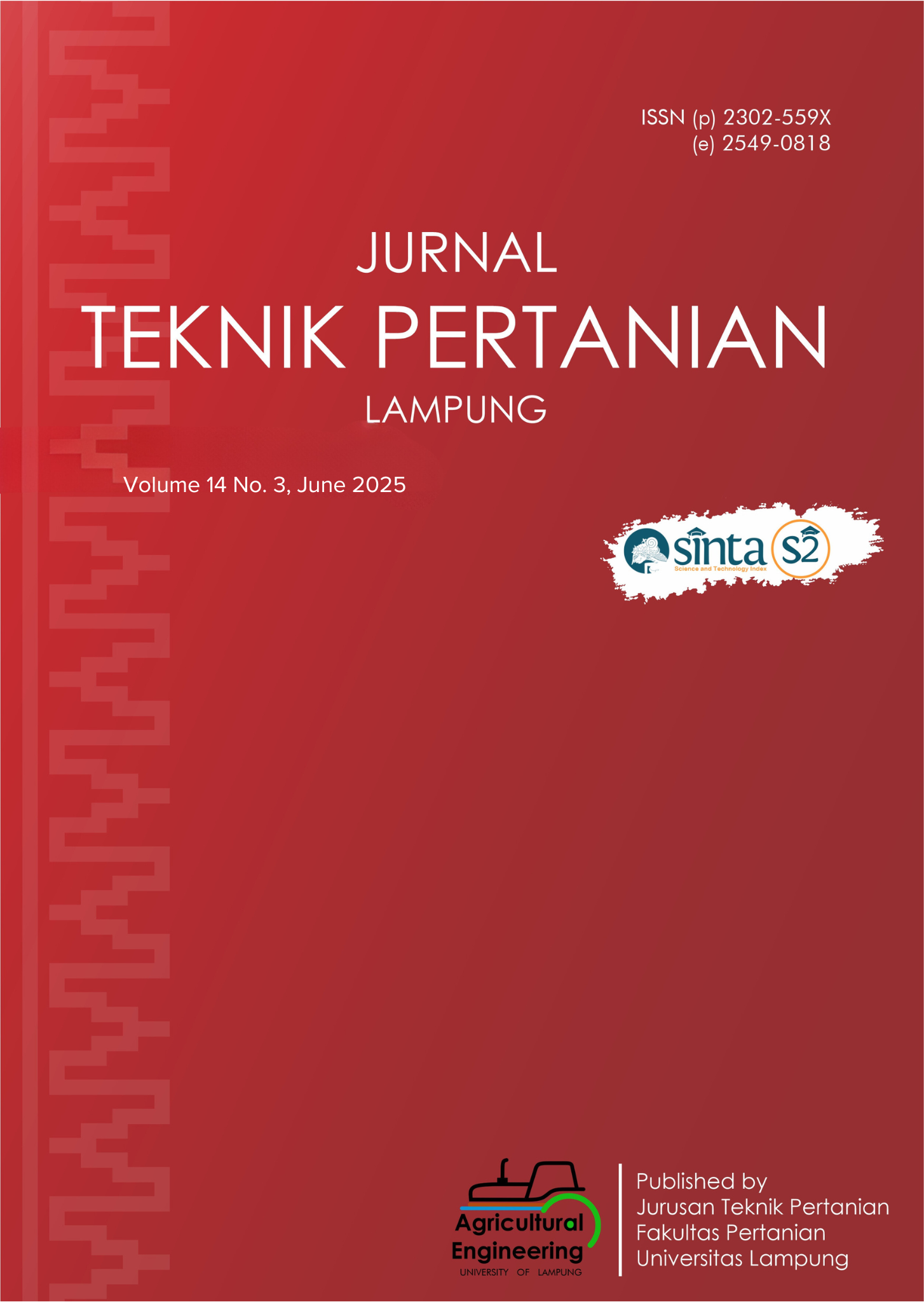Drying Characteristics of Pine Wood (Pinus merkusii Jungh. et de Vriese) Using Hot Air, Infrared, and Combined Infrared-Hot Air
DOI:
https://doi.org/10.23960/jtep-l.v14i3.772-780 Abstract View: 200
Abstract View: 200
Abstract
This research aims to determine the drying characteristics of Merkusii pine wood (Pinus merkusii Jungh. et de Vriese) using three methods, including the hot air drying, infrared, and combined infrared-hot air. The drying characteristics included temperature distribution, reduction in moisture content, drying rate, wood surface temperature distribution, and specific energy consumption (SEC). The results show that the combined infrared-hot air drying method produces a faster drying time and the highest drying rate compared to the only hot air or only infrared drying method. The fastest drying time was 345 min at a treatment temperature of 90°C, air velocity of 3 m/s, and the greatest drying rate was 0.429 gr/min at a temperature of 80°C, air velocity of 3 m/s. Additionally, the combined infrared hot air method produces a more uniform temperature distribution on the wood surface and lower specific energy consumption, specifically 1027.15 MJ/kg.
Keywords: Drying, Hot air, Infrared, Temperature.
Downloads
References
American Society for Testing Material (ASTM). (2003). ASTM D4442-92: Standard Test Methods for Direct Moisture Content Measurement of Wood and Wood-Base Materials. Annual Book of ASTM Standards, 4(10).
Avramidis, S., Lazarescu, C., Rahimi, S. (2023). Basics of wood drying. In Springer Handbook of Wood Science and Technology, 679-706. https://doi.org/10.1007/978-3-030-81315-4_13
Basri, E., Yuniarti, K., Wahyudi, I., & Pari, R. (2018). Teknologi Pengeringan Kayu. IPB Press.
Chan, Y., Himawanto, D.A., Kristiawan, B., & Yaningsih, I. (2023). Isothermal drying kinetic of sengon wood (Paraserianthes falcataria) using combined infrared and hot air: Experimental and modeling study. Jordan Journal of Mechanical and Industrial Engineering, 17(4), 549–554. https://doi.org/10.59038/jjmie/170410
Chan, Y., Himawanto, D.A., Kristiawan, B., & Yaningsih, I. (2024). Short notes: Thermal characteristics of sengon wood drying using infrared and combined infrared-hot air methods. Wood Research, 69(1), 1–8.
Conde, M.J.M., Liñán, C.R., de Hita, P.R., & Gálvez, F.P. (2012). Infrared thermography applied to wood. Research in Nondestructive Evaluation, 23(1), 32–45. https://doi.org/10.1080/09349847.2011.626142
Cserta, E., Hegedus, G., & Németh, R. (2011). Drying process in Norway spruce wood exposed to infrared radiation. BioResources, 6(4), 4181–4189. https://doi.org/10.15376/biores.6.4.4181-4189
Cserta, E., Hegedűs, G., & Németh, R. (2012). Evolution of temperature and moisture profiles of wood exposed to infrared radiation. BioResources, 7(4), 5304–5311. https://doi.org/10.15376/biores.7.4.5304-5311
Cserta, E., Hegedűs, G., Agócs, G., & Németh, R. (2013). Impact of initial moisture content on the drying process of wood exposed to infrared radiation. BioResources, 8(3), 4283–4287. https://doi.org/10.15376/biores.8.3.4283-4287
Dupleix, A., De Sousa Meneses, D., Hughes, M., & Marchal, R. (2013). Mid-infrared absorption properties of green wood. Wood Science and Technology, 47(6), 1231–1241. https://doi.org/10.1007/s00226-013-0572-5
Elustondo, D., Matan, N., Langrish, T., & Pang, S. (2023). Advances in wood drying research and development. Drying Technology, 41(6), 890–914. https://doi.org/10.1080/07373937.2023.2205530
FAO (Food and Agriculture Organization). (2009). ISPM 15 Regulation of Wood Packaging Material in International Trade. Secretariat of the International Plant Protection Convention, Rome, Italy.
Fransiska, Y., Radam, R., & Sari, M.N. (2023). Pengeringan kayu karet (Hevea brasiliensis) menggunakan metode green house degan teknik penyusunan horizontal (rebah) dan vertikal (sandar). Jurnal Sylinva Scienteae, 6(3), 375–383. https://doi.org/10.20527/jss.v6i3.9213
Horák, J., Kuboňová, L., Tomšejová, S., Laciok, V., Krpec, K., Hopan. F., Kubesa, P., Kysučan, Z., & Ochodek, T. (2012). Change in the wood moisture dependency on time and drying conditions for heating by wood combustion. Wood Research, 63(2), 261–272.
International Organization for Standardization. (2003). ISO 6780: Flat Pallets for Intercontinental Materials Handling — Principal Dimensions and Tolerances. ISO Central Secretariat, Vernier (Geneva), witzerland.
Jati, I.S., & Rivai, M. (2020). Implementasi thermal camera pada pengaturan pendingin ruangan. Jurnal Teknis ITS, 8(2), 1–6. http://dx.doi.org/10.12962/j23373539.v8i2.43131
Karlinasari, L., Nawawi, D.S., & Widyani, M. (2010). Kajian sifat anatomi dan kimia kayu kaitannya dengan sifat akustik kayu. Bionatura: Jurnal Ilmu-Ilmu Hayati dan Fisik, 12(3), 110-116.
Kaveh, M., & Abbaspour-Gilandeh, Y. (2020). Impacts of hybrid (convective-infrared-rotary drum) drying on the quality attributes of green pea. Journal of Food Process Engineering, 43(7), e13424. https://doi.org/10.1111/jfpe.13424
Kollmann, F.F.P., Schneider, A., & Böhner, G. (1967). Investigations on the heating and drying of wood with infrared radiation. Wood Science and Technology, 1, 149–160. https://doi.org/10.1007/BF00353386
Lerman, P., Scheepers, G., & Wiberg, P. (2022). A laboratory setup for measuring the wood-surface temperature during drying by means of thermography. Wood Material Science & Engineering, 18(2), 701–706. https://doi.org/10.1080/17480272.2022.2066479
Nurmawati, T., Hadiyanto, H., Cahyadi, C., & Fachrizal, N. (2022). Pengaruh daya lampu terhadap proses pengeringan jamur tiram berbasis lampu infrared. Jurnal Energi Baru dan Terbarukan, 3(3), 239–248. https://doi.org/10.14710/jebt.2022.14627
Ondro, T., Vitázek, I., Húlan, T., Lawson, M.K., & Csáki, Š. (2018). Non-isothermal kinetic analysis of the thermal decomposition of spruce wood in air atmosphere. Research in Agricultural Engineering, 64(1), 41–46. https://doi.org/10.17221/115/2016-RAE
Purnawati, R., & Arifudin, M. (2021). Sifat dan jadwal pengeringan kayu Flindersia pimenteliana. Jurnal Kehutanan Papuasia, 7(2), 208–14. https://doi.org/10.46703/jurnalpapuasia.Vol7.Iss2.253
Putera, H.P., & Listyanto, T. (2021). Relationship between axial location and board thickness variation on the development of drying schedule of cemara gunung (Casuarina Junghuhniana Miq.). Jurnal Sylva Lestari, 9(1), 121-137. https://doi.org/10.23960/jsl19121-137
Sakare, P., Prasad, N., Thombare, N., Singh, R., & Sharma, S.C. (2020). Infrared drying of food materials: Recent advances. Food Engineering Reviews, 12(3), 381–398. https://doi.org/10.1007/s12393-020-09237-w
Sallata, M.K. (2013). Pinus (Pinus merkusii Jungh et de Vriese) dan keberadaannya di Kabupaten Tana Toraja, Sulawesi Selatan. Jurnal Penelitiaperlun Sosial dan Ekonomi Kehutanan, 10(2), 85-98.
Straže, A., Klarić, M., Budrović, Z., & Pervan, S. (2020). Characterisation and modelling of drying kinetics of thin ash and oak wood with infrared radiation and hot air. Drvna Industrija, 71(2), 171–177. https://doi.org/10.5552/drvind.2020.1965
Ye, L., El-Mesery, H.S., Ashfaq, M.M., Shi, Y., Zicheng, H., & Alshaer, W.G. (2021). Analysis of energy and specific energy requirements in various drying process of mint leaves. Case Studies in Thermal Engineering, 26, 101113. https://doi.org/10.1016/j.csite.2021.101113
Downloads
Published
How to Cite
Issue
Section
License
Authors who publish with this journal agree to the following terms:
Authors retain copyright and grant the journal right of first publication with the work simultaneously licensed under a Creative Commons Attribution-ShareAlike 4.0 International Lice that allows others to share the work with an acknowledgement of the work's authorship and initial publication in this journal.
Authors are able to enter into separate, additional contractual arrangements for the non-exclusive distribution of the journal's published version of the work (e.g., post it to an institutional repository or publish it in a book), with an acknowledgement of its initial publication in this journal.
Authors are permitted and encouraged to post their work online (e.g., in institutional repositories or on their website) prior to and during the submission process, as it can lead to productive exchanges, as well as earlier and greater citation of published work (See The Effect of Open Access).
Jurnal Teknik Pertanian Lampung

JTEPL is licensed under a Creative Commons Attribution-ShareAlike 4.0 International License.













